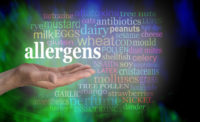Preventing and testing for pathogens and allergens across the food industry

As Food Safety Strategies reports on daily, there are a massive amount of food recalls in the industry. Although some can’t be helped, there are various ways to prevent pathogens and allergens across the food industry, including testing, internal recall audits, and software solutions.
Software
“When testing and detecting pathogens, a critical point of failure is the coordination of samples, batches/lots, and testing results. Generally, a robust Laboratory Information Management System is prudent for ensuring the management between laboratory results and production,” says Thomas Burke, food traceability and safety scientist, Institute of Food Technologists, Chicago.
“These systems are similar to Enterprise Resource Planning software but are specialized to food production and laboratory needs.”
A recall management system is essential for food and beverage processors.
AVEVA, formerly Schneider Electric Software, allows processors to complete product genealogy. This provides full details of which materials were used where, what equipment was employed, and who did what. It also keeps track of the relevant process and product quality settings and the results for each production, packaging and labeling step, as well as what unplanned events occurred and what corrective actions were performed.
During a recall, this genealogy gives processors information and data to determine the root cause. They can then determine which material, ingredient or equipment contaminated the product, and if any other products are affected, which enables them to take corrective action and limit the impact of a recall.
"It must be understood that software cannot prevent or test for pathogens or allergens," says Allen Sayler, senior director, Food Consulting Services, Alexandria, VA. "There are many software programs that can accomplish this, some where a computer with the software is connected directly to the laboratory analytical instruments and the potential for human error during entry is eliminated. Other software requires some or all sampling and testing date to be enter by someone, introducing data entry error to the equation."
The acronym used for this type of software is “LIMS,” which stands for “Laboratory Information Management System," he notes.
"LIMS software can be an effective tool in capturing, organizing and analyzing laboratory testing data on pathogens and allergens. Most of these software programs allow for 'trending' and other types of statistical analysis in order to help food processing facilities fine tune their pathogen detection and allergen cross-contact programs," Sayler says.
Blockchain
“In most cases, a blockchain system is not necessary or even helpful for pathogen detection/analysis,” explains Burke.
While useful for the exchange of traceability information across supply chain partners, laboratory data does not need this level of integration, he says.
“The immutability and timestamping of blockchain is also useful in traceability, but for laboratory results, tools like electronic lab notebooks can fulfill those attributes. Machine learning and AI-based analytical tools would be useful, however, to resolving issues arising in say, environmental monitoring.”
However, in April 2019, Albertsons Companies, one of the largest food and drug retailers in the U.S., joined the blockchain-based IBM Food Trust Network, and began piloting the technology to improve how food is traced from farm to store shelf. The addition of Albertsons Companies to the Food Trust ecosystem of more than 80 brands brings blockchain-based food traceability to more consumers and industry players—from producers to suppliers to retailers—by helping enable greater transparency and collaboration, and ultimately, a safer food supply.
Albertsons Companies, which operates nearly 2,300 stores across the U.S., will pilot Food Trust for tracing bulk romaine lettuce from one of its distribution centers, then will explore expanding to other food categories throughout its distribution network. Albertsons Companies plans to pilot the solution to help overcome the obstacles that have existed when a traceback is initiated for a product like romaine and is evaluating ways to use the technology to highlight the provenance of its extensive Own Brands portfolio.
"Blockchain technology has the potential to be transformational for us as we further build differentiation on our fresh brand," said Anuj Dhanda, chief information officer, Albertsons Companies. "Food safety is a very significant step. In addition, the provenance of the products enabled by blockchain— the ability to track every move from the farm to the customer's basket—can be very empowering for our customers."
Internal recall audits
"The intent of an internal recall audit or 'mock recall program,' which is the more common term used by the food manufacturing industry, is not to somehow detect a weakness in a facilities pathogen detection or allergen cross-contamination program, but to determine the readiness and effectiveness of a facility’s traceability and finished product inventory and distribution system in order to quick identify product, ingredients or packaging that is suspected of causing a food safety problem," says Sayler.
“Internal recall audits help prepare for the event of a pathogen or allergen detection event. It allows for the facility to be well rehearsed in their procedures to recall product as soon as possible,” says Burke. “They do not necessarily reduce the risks of contamination but mitigate the likelihood that compromised product is distributed to the consumer.”
Recalls require the quickest and most accurate response possible, which means that all staff need to be aware of recall procedures and trained to respond appropriately, he notes.
“Recall audits help ensure that the organization is ready if/when a food safety emergency arises,” Burke adds.
The more plant personnel who participate in your facility’s food safety audit, the better, says Stephanie Lopez, vice president, food safety services, Americas, AIB International, Manhattan, KS, in SFWB’s March 2018 food safety column. These educational experiences allow your staff to engage with the audit process and improve their food safety knowledge.
She says that at a minimum, it is strongly recommended that your self-inspection team and internal audit team participate with the auditor. It’s a great way for them to enhance their inspecting and auditing skills. A good auditor will explain what he or she is looking at as they work in a given area. In addition, they will provide comments on positive findings in addition to non-compliances. This is an excellent learning tool and is also beneficial for staff working in the area being audited to participate to give them a fresh perspective on their impact on food safety.
Pathogen testing
Last year, in September 2018, a study was conducted that said that increasing cases of foodborne illnesses due to food contamination and rising consumer inclination toward better quality and safe food are expected to fuel the demand for pathogen testing in the global food safety testing market.
The study, “Food Safety Testing Market by Contaminant (Pathogens, Genetically Modified Organisms (GMO), Chemicals & Toxins and Others), Food Tested (Meat & Meat Products; Dairy & Dairy Products; Cereals, Grains, and Pulses; Processed Foods; and Others), Technology (Agar Culturing, PCR-Based Assay, Immunoassay-Based, and Others): Global Opportunity Analysis and Industry Forecast, 2018-2025,” revealed that the global food safety testing market was valued at $13.14 billion in 2017, and is estimated to reach $23.20 billion by 2025, registering a CAGR of 7.3 percent from 2018 to 2025.
Increase in economically motivated adulterations (EMA) due to high competition and rise in incidence of food frauds as well as various regulations on food safety, especially in the developed economies, are key factors responsible for the robust growth of the food safety testing market. However, high cost of food safety testing, lack of food control infrastructure in the developing economies, complexity in testing techniques and lack of harmonization of regulations hinder the growth of the market. Furthermore, improving stringency of food safety regulations and trend of globalization in food supply trade are expected to provide lucrative opportunities to the market players in future, said the article.
The technologies discussed in the report included agar culturing, PCR-based assay, immunoassay-based and more. The PCR-based assay segment contributed nearly half of the overall market share in 2017, and is expected to maintain its lead position through 2025, contributing a revenue of $11,487 million.
Looking for a reprint of this article?
From high-res PDFs to custom plaques, order your copy today!






